Amarnath caves(Hindi pilgrimage)...!!!
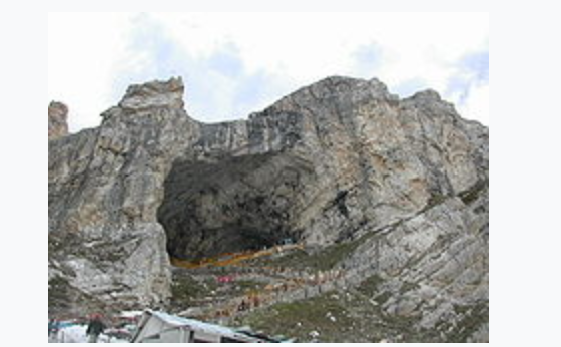
Amarnath cave is a Hindu shrine located in Jammu and Kashmir, India. The cave is situated at an altitude of 3,888 m (12,756 ft),about 141 km (88 mi) from Srinagar, the summer capital of Jammu and Kashmir and reached through Pahalgam town. The shrine forms an important part of Hinduism,and is considered to be one of the holiest shrines in Hinduism.The cave is surrounded by snowy mountains. The cave itself is covered with snow most of the year except for a short period of time in summer when it is open for pilgrims. Hundreds of thousands of Hindu devotees make an annual pilgrimage to the Amarnath cave across challenging mountainous terrain.
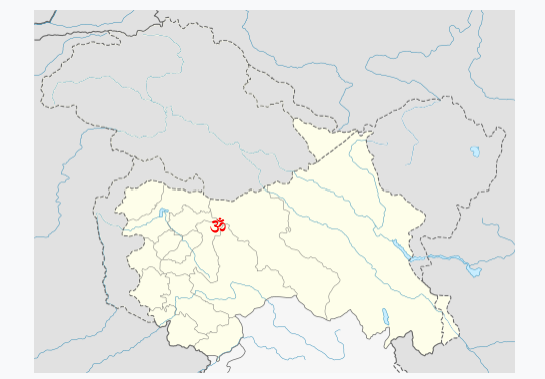
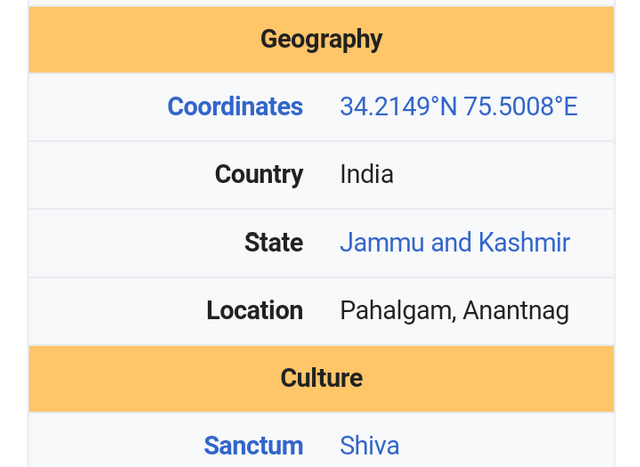
The Linga:
Inside the 40 m (130 ft) high Amarnath cave, a stalagmite is formed due to freezing of water drops that fall from the roof of the cave on to the floor and grows up vertically from the cave floor.It is considered to be a Shiva Linga by Hindus. It is mentioned in the ancient Hindu texts of Mahabharata and Puranas that Lingam represents Lord Shiva.The Lingam waxes during May to August, as snow melts in the Himalayas above the cave and the resultant water seeps into the rocks that form the cave and gradually wanes thereafter.As per religious beliefs, it has been claimed that the lingam grows and shrinks with the phases of the moon reaching its height during the summer festival, although there is no scientific evidence for this belief.According to a Hindu religious beliefs, this is the place where Shiva explained the secret of life and eternity to his divine consort, Parvati.
History:
The book Rajatarangini (Book VII v.183) refers to Amareshwara or Amarnath. It is believed that Queen Suryamathi in the 11th century AD gifted trishuls, banalingas and other sacred emblems to this temple.Rajavalipataka, begun by Prjayabhatta has detailed references to the pilgrimage to Amarnath Cave. Other than this, there are further references to this pilgrimage in many other ancient texts.
Discovery of Holy Cave Edit
According to legend, Bhrigu Muni was the first to have discovered Amarnath. Long time ago it is believed that The Valley of Kashmir was submerged under water and Kashyap Muni drained it through a series of rivers and rivulets. Therefore, when the waters drained, Bhrigu Muni was the first to have Darshan of Lord Amarnath. Thereafter, when people heard of the Lingam, it became an abode of Lord Bholenath for all believers and a pilgrimage which is done by lakhs of people each year.
François Bernier, a French physician accompanied Emperor Aurangzeb during his visit to Kashmir in 1663. In his book “Travels in Mughal Empire” he writes while giving an account the places he visited in Kashmir that he was “pursuing journey to a grotto full of wonderful congelations, two days journey from Sangsafed” when he “received intelligence that my Nawab felt very impatient and uneasy on account of my long absence”. The “grotto” he refers to is obviously the Amarnath cave as the editor of the second edition of the English translation of the book, Vincient A. Smith makes clear in his introduction. He writes: “The grotto full of wonderful congelations is the Amarnath cave, where blocks of ice, stalagmites formed by dripping water from the roof are worshipped by many Hindus who resort here as images of Shiva…..”
Yatra:
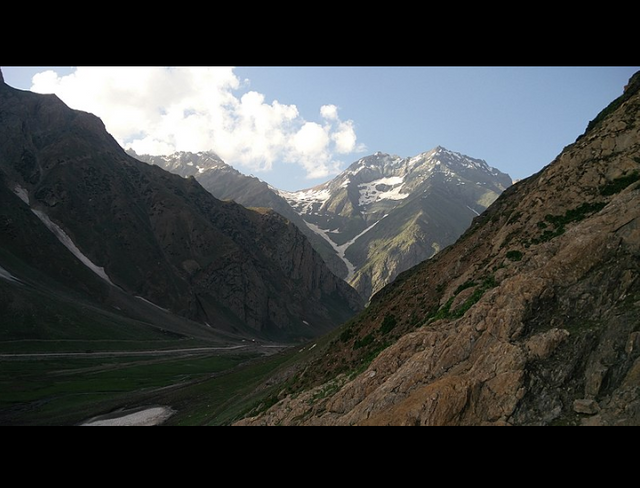
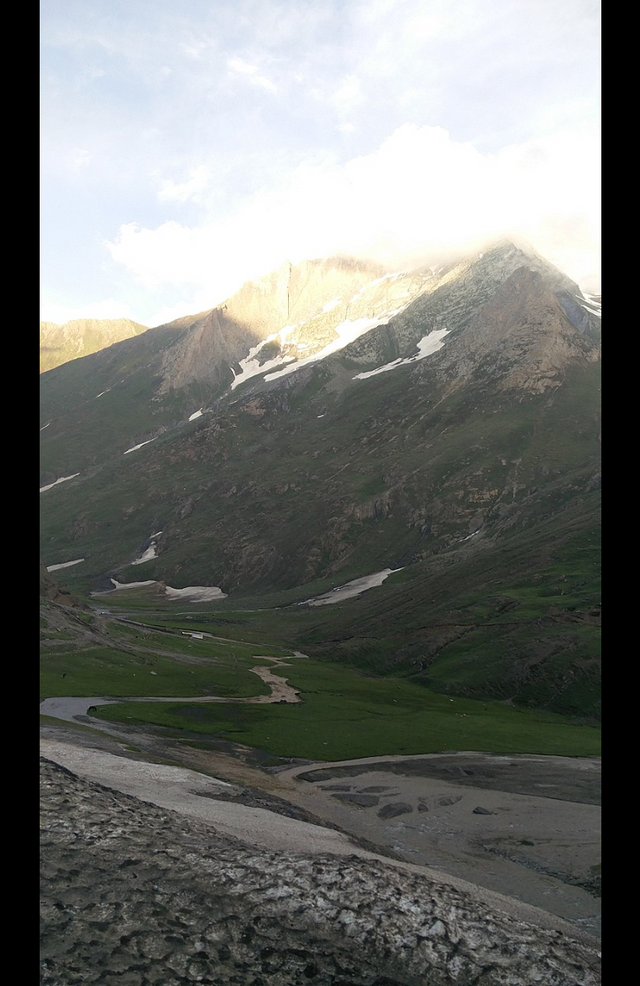
The peak pilgrimage occurs when the iced stalagmite Shiv lingam reaches the apex of its waxing phase through the summer months. The July-August popular annual Hindu pilgrimage, undertaken by up to 600,000 or more pilgrims to the 130 feet (40 m)-high glacial Amarnath cave shrine of iced stalagmite Shiv linga at 12,756 feet (3,888 m) in the Himalayas, is called Amarnath Yatra.It begins with a 43 kilometres (27 mi) mountainous trek from the Nunwan and Chandanwari base camps at Pahalgam and reaches cave-shrine after night halts at Sheshnag Lake and Panchtarni camps.The yatra is both a way of earning revenue by the state government by imposing tax on pilgrims,and making living by the local Shia Muslim Bakarwal-Gujjars by taking a portion of revenue and by offering services to the Hindu pilgrims, and this source of income has been threatened by the Kashmiri militant groups who have harassed and attacked the yatra numerous times,causing killings and massacres, with at least 59 people killed till July 2017 on this yatra causing death of mostly Hindu pilgrims, at least 10 Muslim civilians, and security forces personnel.
The Harkat-ul-Mujahideen group had in the past imposed what it called a "ban" on the yatra in 1994, 1995 and 1998 while threatening the pilgrims of "serious consequences".The Amarnath pilgrimage was suspended in July 2016 due to the Kashmir unrest.A section of Sufis and Shias later demanded resumption of the Yatra.Kalbe Jawad, a Shia cleric and general secretary of Majlis-e-Ulama-e-Hind and Sufi Cleric Syed Hasnain Baqai expressed concern that the tradition had been suspended because of upheaval in Kashmir.
The number of pilgrims to the site has risen from around 12,000 in 1989 to over 400,000 in 2007.This popular yatra destination for Hindus, received about 634,000 people in 2011, the highest recorded number for the site.The number was 622,000 in 2012 and 350,000 in 2013. Pilgrims visit the holy site during the 45-day season around the festival of Shravani Mela in July–August, coinciding with the Hindu holy month of Shraavana.
The beginning of the annual pilgrimage, called Amarnath Yatra is marked by 'pratham pujan' to invoke the blessings of Shri Amarnathji.
In olden days the route was via Rawalpindi (Pakistan) but now a direct train is there connecting rest of India to Jammu, the winter capital of the State. The best part of journey is between Guru Purnima and Shravan Purnima. But the highly unpredictable weather of the mountains should be more obliging before Guru Purnima as rains would not start. There is a bus service from Jammu to Pahalgam (7,500 ft.). At Pahalgam the pilgrims arrange for coolies or ponies to carry gear of food and clothes etc. Everybody remains busy making arrangements for the Yatra. The golden glow of, the sun falls on the turbulent river at Pahalgam. Pahalgam in Kashmiri means the land of shepherds.
Route:
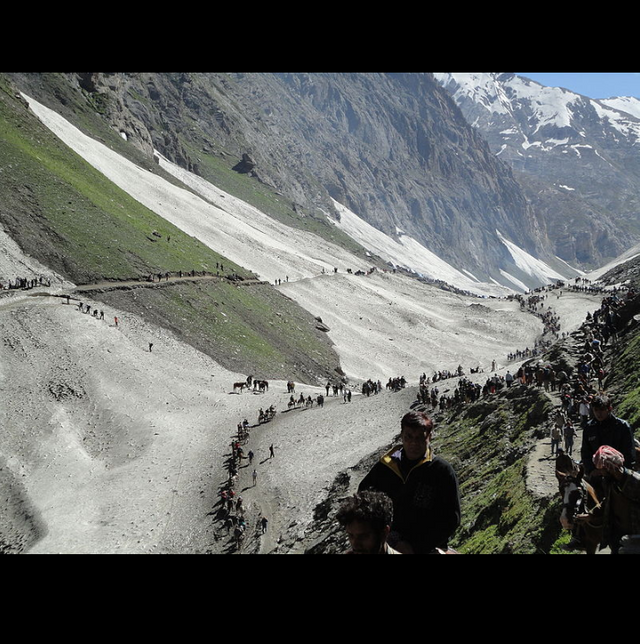
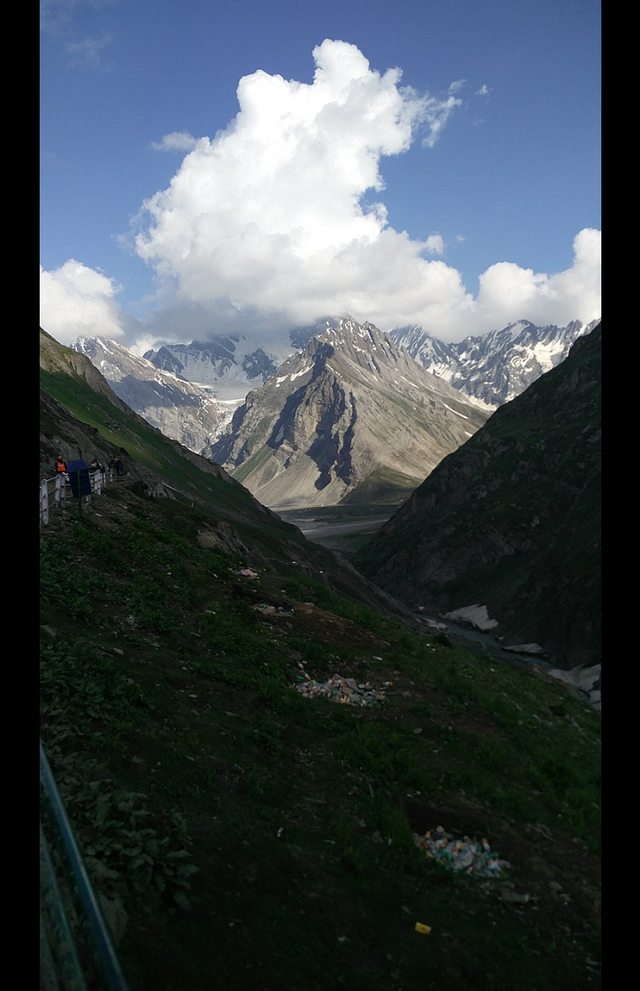
Devotees travel on foot, either from Srinagar or from Pahalgam."The latter journey takes approximately 5 days".
The State Road Transport Corporation and Private Transport Operators provide the regular services from Jammu to Pahalgam and Baltal. Also privately hired taxis are available from Jammu & Kashmir.
The shorter northern route is just about 16 km long, but has a very steep gradient and is quite difficult to climb. It starts from Baltal and passes through Domel, Barari, and Sangam to reach the cave. The northern route is along the Amarnath valley and all along the route one can see the river Amaravati (a tributary of Chenab) which originates from Amarnath Glacier.
It is believed that Lord Shiva left Nandi, the bull, at Pahalgam (Bail Gaon). At Chandanwari, he released the Moon from his hair (Jata). On the banks of Lake Sheshnag, he released his snakes. At Mahagunas Parvat (Mahaganesh Mountain), he left his son Lord Ganesha. At Panjtarni, Lord Shiva left behind the five elements - Earth, Water, Air, Fire and Sky. As a symbol of sacrificing the earthly world, Lord Shiva performed the Tandava Dance. Then, finally, Lord Shiva entered the Holy Amarnath Cave along with Mata Parvati.
Facilities:
En route the cave, various non-profit organizations have set up food supply and resting tents called pandals which are available for free to the pilgrims. Near the shrine, hundreds of tents which are erected by locals can be hired for a night's stay. Helicopter services from base camp to Panjtarni (6 km from the cave) are also available from various private operators.
Security:
Every year, thousands of central armed forces and state police personnel are deployed to provide security to pilgrims from potential terror threats. The forces position at various halts and also in the perimeter of the shrine.
Deaths:
Of the 622,000 yatra pilgrims in 2012, 130 died during the yatra. The major cause was attributed to people who were not physically fit for the arduous climb, high elevations, and adverse weather undertook the yatra. Some also died in road accidents before reaching the base camp from where the yatra starts. Of the 130 deaths, 88 were due to purported health reasons and 42 in road accidents. The 2012 pilgrimage ended on Shravana Purnima (Raksha Bandan) Day, 2 August 2012.
Organisers:
Officially, the Yatra is organised by the government in collaboration with the Shree Amarnath Shrine Board (SASB). Various agencies provide necessary facilities all along the route during the Yatra period, which includes provision of ponies, supply of power, telecommunication facilities, firewood and setting up of fair price shops.
1990's bans and 1996 yatra tragedy:
The pilgrimage was banned from 1991 to 1995 due to threats from terrorists. In 1993, Pakistan-based Harkat-ul-Ansar announced a ban on the annual Amarnath yatra. In 1996 the militants had assured that they would not interfere allowing a resumed yatra with far greater numbers than in previous years. However, unseasonal blizzards in late August of that year led to a tragedy that claimed the lives of 242 yatris, killed by exhaustion and exposure.
If you like this post then please upvote it...
Thankyou@ZAID9...
Hi! I am a robot. I just upvoted you! I found similar content that readers might be interested in:
https://en.wikipedia.org/wiki/Amarnath_yatra